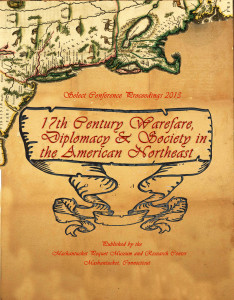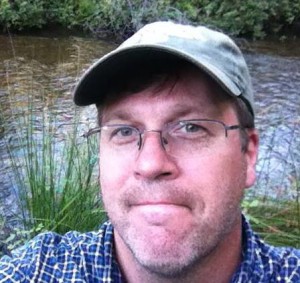Conference Proceedings
ON OCTOBER 18 & 19, 2013 THE MPMRC HOSTED A MAJOR ACADEMIC CONFERENCE IN CONJUNCTION WITH ITS 15TH ANNIVERSARY.
This two-day interdisciplinary conference brought together multi-disciplinary scholars to examine the complexity of a changing cultural landscape, and the consequences of colonization and warfare.
Conference sessions include: War & Ties That Bind, Wampanoag Historical Landscapes of the 17th Century, War & Diplomacy: Politics & Conflict, Memory & Legacy, Gender & Society, Material Culture and Narratives & Language.
Selected papers presented at the conference are now be available for you to download and enjoy!
________________________________________________________________________
Historiography of the Pequot War
Ashley A. Bissonnette and Kevin A. McBride, Mashantucket Pequot Museum and Research Center
This paper examines written primary and secondary sources of the Pequot War (1636-1637) that are used to guide archaeological research strategies and interpret and contextualize recovered battle-related artifacts recovered from various battlefields associated from the Pequot War. The Battlefields of the Pequot War is a long term collaborative project between the Mashantucket Pequot Museum & Research Center and the University of Connecticut and supported by the National Park Service American Battlefield Protection Program. The project, in its eight year, has documented three major battlefields and dozens of actions such as the Battle/Massacre of Mistick Fort, the English Withdrawal and Counter-attack following the attack on Mistick, and the Siege and Battle of Saybrook Fort. In order to document these sites, the well-known accounts of John Mason (commander of Connecticut forces during the war), John Underhill (second in command to Mason), Lion Gardiner (Saybrook Fort commander), and Philip Vincent were subjected to an intensive program of historical source criticism. This analysis contextualized relevant information and reconstructed battle events to understand the broader cultural, social and military aspects of the Pequot War from both a Colonial and Native perspective. Even four hundred years after the conclusion of the Pequot War, it remains one of the most controversial and significant events in the Colonial and Native history of America resulting in hundreds of articles, monographs, books, and pamphlets in American and Europe. The analysis has been multi-focused on the political, social and economic causes and consequences of the war, including the complexity of intertribal, inter-Colonial, and Native-Colonial relations of the period.
View the full version of his paper: a-bissonnette-and-k-mcbride-historiography-of-the-pequot-war
————————————————————————–
Udder Destruction: The Role of the Dairy in the Creation of Conflicts between English Colonists and Native Americans in 17th Century New England
Lindsay Randall, Robert S. Peabody Museum of Archaeology at Philips Academy
The English dairy tradition played a vital role in shaping English settlements in New England during the 17th century through its impact on many facets of daily life – survival, economics, cultural continuity, and religious endeavors. The English tradition of livestock husbandry associated with the dairy soon became a source of animosity between native people and the English colonists. The breakdown in the relationship of the two groups was due in part to the amount of crop damage that native people suffered as a result of wandering cattle as well as the territorial expansion undertaken by colonists in an effort to support their cattle. Another fundamental problem that arose was the general unwillingness on the part of the colonists to change what they viewed as benign practice and was seen as a cornerstone to their English identity and wellbeing. In response to the destruction that the cattle wrought and lack of English concern or recognition regarding these issues, many native people would physically attack not only English colonists but cattle as well. These attacks occurred as a response to the hostility native people felt toward these animals while also serving as a psychological warfare tactic, meant to strike fear and terror into the English. Although the actions of the English cattle and their owners were not the sole cause in the deterioration of the relationship between colonists and native people, they did create and foster hostile interactions between the two groups. It is in this manner that the animals and products associated with the seemingly mundane English dairy system served as one of the many catalysts for conflicts such as King Philip’s War.
View the full version of his paper: Lindsay Randall, Udder Destruction
ABOUT THE AUTHOR
Lindsay Randall is an educator at the Robert S. Peabody Museum of Archaeology at Phillips Academy, Andover where she teaches topics in anthropology, archaeology, and Native American history. Each year she leads a three-week trip for students from Phillips Academy, the Pueblo of Jemez, and the town of Pecos, New Mexico. Lindsay holds a B.A. in History from Keene State College and a M.A. in Historical Archaeology from the University of Massachusetts, Boston, where she participated in a field school on the Eastern Pequot reservation. Her research interests include English history, colonial New England, and Native American issues, both historical and contemporary.
———————————————————————-
In Search of the True Sword: Unique Memories and Legacies of the Pequot War
Laurie Lamarre, Fairfield Museum and History Center
“I tried to secure the old blade. I employed the most powerful purchases. I plied the power of love ; I tried the potency of money. But all was in vain. Like the old warrior owner, its present proprietors were invincible. I was obliged to retreat without the spoils. And I freely confess that I do not censure the family pride and patriotism that, with such a tenacious grasp, hold the ancient, blood dipped, family sword” – Mystic Pioneer, July 30, 1859
On the early morning of May 26, 1637 Captain John Mason led a fighting force of approximately three hundred English and Native allied troops in an attack on the fortified Pequot village of Mistick. As a result of this attack, hundreds of Pequot were killed, the tribe was driven from their homeland, and the English settlement of southeastern Connecticut ensued as right of conquest. English Pequot War veterans, most notably Captain John Mason, settled in southeastern Connecticut now present-day Groton and Stonington, less than a decade after the war. Generations later, descendants have kept the legacy of the Pequot War alive with accounts that recall – some painfully, and some admirably – the events that took place at Mistick Fort. Written by English veterans, proud descendants, and early antiquarians, these memories appear in newspapers, diaries, and museum collections, and are often associated or attributed to specific items and/or individuals. Commander of the Pequot War English allied forces, John Mason left behind a formidable object: an “ancient, blood dipped, family sword.” This paper attempts to explore the history of John Mason’s legacy through the objects he left behind, and to track their legacy through their creations, service, and descent through the Mason family line.
View the full version of his paper: Laurie Pasteryak Lamarre – In Search of the True Sword
ABOUT THE AUTHOR
Laurie Pasteryak Lamarre is currently the curator of exhibitions at the Fairfield Museum. She holds a B.A. in History & Anthropology from UConn and a M.A. in Museum Education from Tufts University. Lamarre, formerly the executive director of the Institute for American Indian Studies, has also served in research, management and education positions at the Mashantucket Pequot Museum & Research Center, USS Constitution Museum, Mattatuck Museum, and Lebanon Historical Society. She is personally interested in how museums of all shapes and sizes open pathways and inspire empathy for cross cultural understanding.
————————————————————————–
To “supply them with Indian boys enough:” The Plight of Children in King Philip’s War
Melissa J. Harris, University of Nebraska Omaha
Abstract:
Historians have paid considerable attention in recent years to the silent voices of King Philip’s War, most notably those of the Native Americans involved in both sides of the conflict. Another silent group, one that has received less attention and scholarship, also existed during this conflict: Native American and English children. Children were at the center of the fighting and discord in King Philip’s War; something that comes to light through the analysis of seldom?cited court documents and letters, as well as the more often employed resources such as contemporary war narratives and captivity narratives. These children, ultimately the most helpless in the hostilities, experienced as much violence and transgression as adults of the opposing sides.
In this paper, I examine how both Native American and English leadership used children to gain advantage for themselves while exerting leverage against their enemies. In addition, both sides used children in an attempt to marginalize the enemy at the same time. Important scholarship exists on Indian servitude in New England, which affected many Native children as a result of the war. This paper supplements and expands upon this research, and includes other methods used on the children to gain advantage in the war, including captivity, cultural hegemony, and death. By analyzing a heretofore understudied group of people, my paper allows for a useful reflection on both Native American and English societies in New England and their perspectives on the obligations and functions of children in a society in crisis.
View the full version of his paper: Melissa Harris – To supply them with Indian boys enough
ABOUT THE AUTHOR
Melissa Harris is currently working toward completing a Master’s degree in American history at the University of Nebraska at Omaha. Her program’s focus is on early American history and Native American studies. As a recipient of the school’s Shuflata Thesis Fellowship, Melissa is completing a thesis on the Native American slave trade as a result of King Philip’s War. She enjoys researching Puritan New England, women’s history, and European-Native American relations.
————————————————————————–
“Usurpation and violence:” The Pequot Wars, Kieft’s Wars and the Decade of Conflict (1635-1645)
David Naumec, Mashantucket Pequot Museum & Research Center & Clark University
Abstract:
By the seventeenth century the lives of the Native Americans and Europeans settled within the present borders of New York and New England became ever increasingly entwined through sustained Dutch and English contact and colonization. Tensions between Europeans and Natives resulted in several successive conflicts, the likes of which had never been encountered before in the northeast. The most prominent of which are known today as the Dutch-Pequot War (1635-1636), Pequot War (1636-1637) and Kieft’s War (1640–1645). During each conflict Native and European forces adopted their culturally specific military tactics, command structures, equipment, and technologies to combat their new opponents. More often than not, Native forces were quicker to modify their military structures and tactics than their European opponents. Even thought the Dutch and English were economic rivals they shared military intelligence and provided official and unofficial assistance to each other during this tumultuous period.
These regional wars are acknowledged as watershed moments for Native, Dutch, and English peoples in the northeast but are typically viewed as unrelated events. The aftermath of these conflicts permanently shifted the balance of power in the northeast in favor of the English who claimed much of present-day southern New England. They share an entangled history due to their temporal immediacy, geographic proximity, as well as the political and social relationships of various participants. A comparative analysis of this period suggests that both the Pequot and English experience during the Pequot War of 1636-1637 was influenced by the war fought between the Dutch and English around the House of Hope a year earlier. The conflicts collectively known as Kieft’s War fought in New Netherland between 1640 and 1645 provide a striking example of how the English victory over the Pequot influenced many aspects of Dutch political and military strategies employed two years later which resulted in the devastation of the colony. When viewed as a inter-related series of military-political events a “decade of conflict” between lasting from 1635 to 1645 emerges and if not for English victory over the Pequot in 1637, the conflicts collectively known as Kieft’s War may not have occurred at all.
View the full version of his paper: David Naumec – Decade of Conflict
ABOUT THE AUTHOR
David J. Naumec is the Senior Historian and Staff Archaeologist at the Mashantucket Pequot Museum and Research Center. Mr. Naumec serves as the military historian and archaeologist for all museum Battlefield Archaeology projects. He holds a B.A in Public History Administration from the University of Connected and has completed a Master’s Degree in History & Museum Studies from Tufts University. Mr. Naumec specializes in Connecticut History, Early American History, and American Military History and has worked as a museum professional and research consultant at the Pequot Museum since 2000. He is currently a doctoral candidate at Clark University in Worcester, Massachusetts.
———————————————————————
“USE DILATORY MEANS:” WILLIAM PYNCHON AND THE NATIVE AMERICANS
David M. Powers, Independent Scholar
Abstract:
In his respectful treatment of Native American culture, rights, and even language, William Pynchon (1590-1662), the founder of Springfield, Massachusetts, differed dramatically from his fellow Puritans of the pioneer era in New England. Why was his approach to indigenous peoples so distinctive?
The often contentious interactions between Puritans and Native peoples in the seventeenth century, epitomized by the tragedy of the 1637 Pequot War, have been well-documented (Jennings, 1975; Salisbury, 1982; Cave, 1996; Katz, 1999; Bailyn, 2012). So have the faith-based methods of the Rhode Island colonist Roger Williams and the “Apostle to the Indians,” John Eliot, (Cogley, 1999). But the exceptionally irenic approach of Pynchon awaits further investigation.
Crucial to Pynchon’s political viability and economic success were his uniquely cordial, collaborative relationships with the Native peoples of the Connecticut River Valley. Motivated in part by the precarious position he occupied on the frontier, he repeatedly urged caution and acted with restraint. He opposed military engagement against Native Americans at every turn, including the Pequot War, where he played a part in ending the hostilities. As a careful and close observer of inter-tribal relationships he offered advice opposed to prevailing attitudes. He avoided provocative actions when involved in business for the colonial governments. He made a real effort to be seen to administer justice even-handedly, with an eye to building and retaining trust with his Native American trading partners; Native Americans won the cases they brought in Pynchon’s Springfield court.
This paper will analyze relevant texts from Pynchon’s time in America (1636 to 1651), including his 1636 deed with the Agawam tribe, his letters to other Puritan leaders, pertinent records of the Connecticut and Massachusetts Bay colonies, and his own memoranda as a magistrate on the Western Massachusetts frontier. It will reveal a unique, consistently articulated policy and practice of respect for indigenous peoples. For instance, the Pynchon deeds addressed questions of shared land use and native culture. They suggest an opening to Native American rights at a time when there were no deeds whatsoever for other English settlements such as Plymouth, Salem, Boston, and Hartford.
Though his perspective was marred by blind spots and ethnocentric assumptions, the remarkable, under explored story of William Pynchon (who was also author of the first book banned, and burned, in Boston) suggests an alternative path for Native American – English relationships – but regrettably a road not taken.
View the full version of his paper: Powers, David – Use of Dilatory Means. William Pynchon and the Native Americans
ABOUT THE AUTHOR
David M. Powers is the author of Damnable Heresy: William Pynchon, the Indians, and the First Book Banned (and Burned) in Boston (Wipf & Stock, 2015). A native of Springfield, MA, he was educated at Carleton College, Northfield, MN, where he majored in Latin, and Harvard University, Cambridge, MA. His historical research, writing, and speaking on the Puritan era in New England continues a life-long interest in early American history. He lives on Cape Cod.
————————————————————————–
Wampanoag Men, the Colonial Army, and Native Martial Culture in the Late 17th Century: Benjamin Church’s Indians Reconsidered
Brian D. Carroll, Central Washington University
Abstract:
Mid-way through King Philip’s War, the coalition of Wampanoag bands and villages arrayed against colonists disintegrated as English victories mounted. One group, the Sakonnet, opened a dialogue with a colonial officer, Benjamin Church, and agreed to support the English. Along with other Native allies the Sakonnet serving under Church proved crucial in securing the colonist’s victory. A dozen years later, once again, the Sakonnet, along with other Wampanoag, fought for Church in King William’s War, playing a pivotal role in a series of offensives against the Wabenaki Confederacy in Maine and Acadia.
This study identified not only who the men were who fought for Church, it examines their experiences in the colonial army and their cultural motives for fighting for the English. This investigation reveals that Native attitudes towards warfare remained important decades after conquest. Despite being incorporated into a colonial military structure, many aspects of Native martial custom carried over into this new setting as they became ethnic soldiers for the British. These included the continuation of Algonquian purification rituals associated with war, rituals surrounding the appointment of war captains (pneise in Algonquian), and an organizational and leadership structure that mirrored Native war parties. However, other cultural practices were transformed in the new imperial setting, such as scalping, significantly altered by the introduction of commercial bounties. The colonial military became an important proving ground for young warriors, bolstering Native masculinity (at the time under attack by European missionaries) – as well as providing potential leaders opportunities to gain social status.
View the full version of his paper: Carroll Brian – Wampanoag Martial Culture 17th 18th Century
ABOUT THE AUTHOR
Brian D. Carroll is Assistant Professor of History and American Indian Studies at Central Washington University. His articles have been published in The New England Quarterly, Early American Studies, and the William and Mary Quarterly, among other publications. He is currently revising a book manuscript, “From Warrior to Soldier: New England Indians in the Colonial Military,” an ethnohistorical study of the experience of Native Americans in the region’s armies during the colonial wars. Brian is also working on a second book, “Burning the Hearts of the Dead: Medicine, Migration and Vampire Belief in Early National New England.” His research has been supported by fellowships from a variety of institutions, including the American Antiquarian Society, the Huntington Library, and Harvard University’s Center for the History of Medicine.








